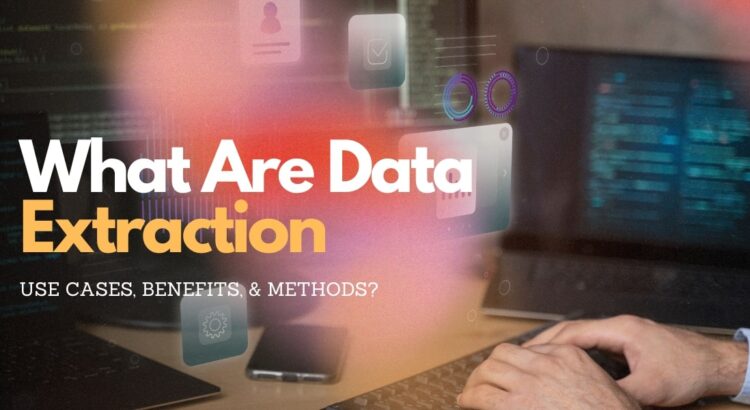Data extraction is scraping information from other websites or sources. Data has surrounded. Various applications and software on electronic devices like smart phones and laptops are deployed to automatically collect data for insights into their behaviour, investments, and likelihoods. It explains how significant the data is. This is why global corporations want it, expanding the horizons of their markets. Its market size was worth $2.73 billion in 2022 and is likely to be $5.93 billion by 2029, with a compound annual growth rate of 11.9%, as per a report.
What is data extraction?
Data extraction is typically the process of reaching out to data sources and collecting them, no matter how unorganised or unstructured they are. With the extraction methods, it is easy to consolidate, process, and refine the collected data. So, it can be standardised and centralised for transformation on-site, in the cloud, or at a at a hybrid location. This process defines the very first stage of the ETL (Extract, Transform, Load) process.
Data Extraction and ETL
Scraping data is a part of the ETL process. This process is crucial because it helps in collecting and consolidating datasets from a variety of sources into a specific location. Also, it takes in different types of records to convert them into a common format.
Considering the ETL process, it involves the following steps:
1. Extraction
The very first process is extraction, which means taking data from one or more sources to collect in another location or system. It emphasizes locating and identifying relevant datasets so that they can be prepared for processing or transformation. This process combines different records to be placed together for data mining or business intelligence.
2. Transformation
Transformation refers to refining the structure and quality of data toward an objective. It majorly involves the cleansing process, which helps in sorting, organising, and sanitising them. Let’s say the cleansing process targets dupes or duplicate entries to be deleted and missing values to be put to enrich information. Overall, this process facilitates reliable, consistent, and usable data to be in place.
3. Loading
The third process does not involve any kind of technical processing but rather shifts high-quality data to a single and unified location. It can be on the cloud or on a on a server, where analysts can look into them to discover valuable strategies that prove realistically working and helpful.
Similarly, retailers such as Office Depot may be able to collect customer information through mobile apps, websites, and in-store transactions. But without a way to migrate and merge all of that data, its potential may be limited. Here again, data extraction is the key.
Data Scraping Use Cases
Multiple companies and organisations frequently pull out information for multiple uses. Here are some use cases:
- Market Research Firms: Various research companies, like Statista and Gartner, rely on extraction techniques to collect and analyse industry trends.
- Business Intelligence Companies: Companies that are involved in extraction and analysis services develop business intelligence software and services like Tableau use extraction for data collection.
- Web Scraping Services: Some companies like Scrapy specifically deal in scraping projects, which require data for business purposes like price monitoring, lead generation, etc.
- Cybersecurity Firms: Another interesting objective is security intelligence, which is achieved through this process. Also, companies like FireEye invest in it to overcome cyber threats.
- Social Media Monitoring Companies: Hootsuite-like companies rely on this process to monitor whatever is happening on social media platforms for online reputation building, understanding customer sentiments, etc.
- Artificial Intelligence and Machine Learning Companies: This is the most crucial use case, as it involves companies like Google DeepMind. These companies scrape data to improve, train their AI models, and derive intelligence.
Methods of Data Extraction
The wise use of technologies involves amazing methods. Considering data extraction techniques or methods, these are the most recommended ones:
- Web Scraping Tools: It’s extremely simple and the fastest method. You just integrate your query and let tools like Octoparse automatically scrape data for you from desirable websites.
- APIs (Application Programming Interfaces): This involves scripting to define and interact with predefined endpoints (websites) to collect data from applications or sites.
- Database Queries: This is another interesting method that involves the use of SQL or similar languages to pull out data from any defined database.
- Data Crawling: Like crawling into websites by Google bots, this method refers to systematically scanning the target web data or sources for extraction.
- Screen scraping: This method guides in capturing and extracting the display output of any applications using some tools.
- Text Parsing: It is focused on extracting text using natural language processing tools or algorithms.
- File Parsing: This method enables you to extract data from certain files, which can be CSV, XML, or JSON for scraping data.
- Data Integration Tools: The extraction of data can help in developing data integration tools or using them.
Benefits of the Extraction Tool
Various companies or organisations can resolve a variety of objectives through extraction because it will eventually generate a database full of interesting statistics and facts. Not only that, but these statistics or facts might have some significant information that can be filtered out. Organisations can leverage these advantages:
- Access to Diverse Data Sources: A range of data sources can be targeted, including websites, databases, and applications. It can also be used for thinking innovatively to drive valuable strategies.
- Enhanced Decision-Making: The extracted pieces of information carry valuable insights. Entrepreneurs can also use it to support their decision-makers who strategically plan.
- Improved Efficiency: The very next advantage is to improve efficiency. It involves automatic data collection processes, which eventually save time and reduce manual effort.
- Cost Reduction: Companies are relying more on tools for collecting data, which reduces the cost of hiring an in-house operations team.
- Data Consolidation: This process simplifies combining data from multiple sources so that a comprehensive overview can be taken.
- Facilitation of Data Analysis: Mainly, data scraping targets driving intelligence. This method can be helpful in collecting a database for analytics and machine learning applications.
- Competitive Advantage: One can effortlessly discover market trends, customer behaviour, and competitors to counter-challenge them strongly.
- Compliance and Reporting: It can also show you the gaps in complying with regulations. So, you can create an accurate report for further examination or legal purposes.
- Customisable Extraction: If a company is planning to introduce something new, the scraped data can help in discovering the market trend and efficiency to achieve this possibility.
- Scalability: Lastly, it can present the upsides of your productivity and growth, which businesses may discover and enhance to scale up their productivity and business reach.
Conclusion
Data extraction or scraping are technical processes that help in retrieving or collecting data for any business objective. It can help in achieving various objectives and benefit businesses eventually through the processing of the retrieved data.



